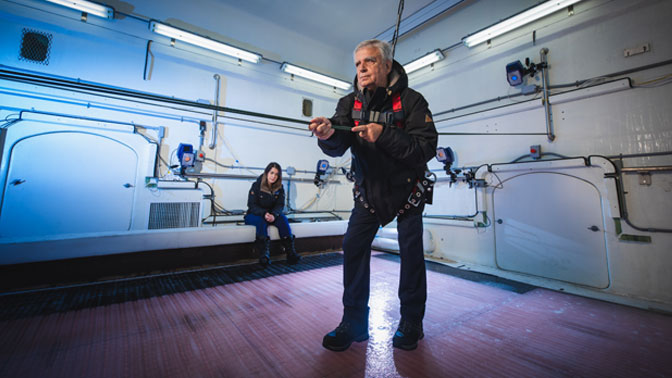
Falling on ice is the leading cause of occupational injuries for people who work outdoors during the winter. While footwear with slip-resistant soles may help to prevent falls, until recently there was no standardized way to measure the grip that shoes have on outdoor ice-covered surfaces.
To solve this problem, a team led by Scientist Dr. Tilak Dutta and Affiliate Scientist Dr. Z. Shaghayegh Bagheri at The KITE Research Institute investigated whether shoes that demonstrated slip-resistance in the lab also reduced the risk of slips and falls in real-world conditions.
The laboratory test that was used is called the Maximum Achievable Angle test. It measures the steepest ice-covered incline that participants can walk up and down on without slipping. The test was carried out in KITE’s WinterLab, a climate-controlled simulator that can replicate winter conditions, such as snow and ice.
“In our previous study, we identified a few types of winter boots that far outperformed others on icy slopes in the simulator. These boots had outsoles that were made of advanced materials designed to stick to ice. They were usually made of two or more different materials, known as composite materials,” says Dr. Dutta. “We wanted to test how well the footwear with composite outsoles would perform in real winter conditions outside the lab, where icy surfaces are more varied than in WinterLab.”
The team recruited personal support workers that made home visits during the winter and split them into two groups. One group was provided a pair of boots with composite soles that showed high slip-resistance in the lab. The second group used their own footwear—none of which included composite materials. The study found that participants who were wearing the lab-tested boots experienced around 68% fewer slips and 78% fewer falls than the group that wore their own footwear.
Dr. Dutta comments, “These findings show us that we can be confident in the results of our lab-based test to help consumers choose safer winter footwear, while also helping employers confidently recommend footwear that will reduce the risk of occupational injury.”
To see how your boots performed using the same laboratory slip test, visit Rate my Treads.
This study was supported by the Ontario Ministry of Labour, Training and Skills Development.
Bagheri ZS, Beltran JD, Holyoke P, Dutta T. Reducing fall risk for home care workers with slip resistant winter footwear. Appl Ergon. 2021 Jan;90:103230. doi: 10.1016/j.apergo.2020.103230. Epub 2020 Aug 25. PMID: 32858393.

(L-R) First author of the study and Affiliate Scientist at KITE Dr. Z. Shaghayegh Bagheri, and KITE Scientist Dr. Tilak Dutta.




